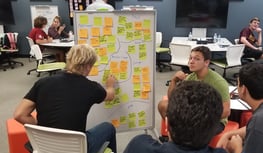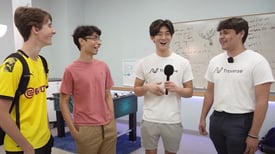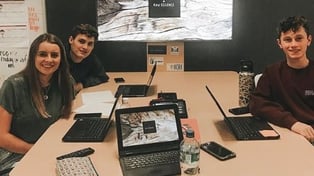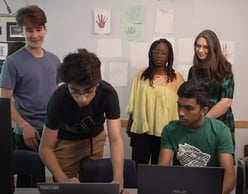Are we limiting our students?
Over the last decade, K-12 schools have focused on the role student voice and agency play not only in boosting academic achievement but in developing “real-world” skills like resilience, adaptability and critical thinking. But our traditional approaches to education still create unintended limits on the agency kids have over their learning. Take the common task of having students work on a team project. Even if a teacher allows students to select their own teams, they’re collaborating with classmates who are the same age and learning the same things.
thinking. But our traditional approaches to education still create unintended limits on the agency kids have over their learning. Take the common task of having students work on a team project. Even if a teacher allows students to select their own teams, they’re collaborating with classmates who are the same age and learning the same things.
But what if we removed those limitations? What if we gave students the agency to create teams based on the demands of the task rather than the convenience of class schedules — or even school locations? The system I lead, Leander Independent School District near Austin, Texas, is focused on empowering students to own their learning. This empowerment allowed four students from two schools to create a product developed for Uncharted Learning’s entrepreneurship education courses. The collaboration resulted in national recognition for the team’s project. More importantly, the four kids reaped the benefits of peer-to-peer learning, something most people don’t learn until they’re in the workforce.
Breaking down barriers
 The story begins in 2019, when Cesar Gamez and Steven Homan were juniors at Vista Ridge High School in the Leander Independent School District. For their INCubatoredu course, they created Traverse, a peer-to-peer rental marketplace. When they enrolled in ACCELeratoredu the following year, they realized they needed developers to build out the technical specifications for Traverse. Dana Jones, an entrepreneurship teacher, mentioned two students at nearby Cedar Park High School, Aiden Seibel and Yash Shah. Both were enrolled in Uncharted Learning’s MobileMakersEdu, a course where students learn coding and design skills with an eye toward entrepreneurship. Aiden, like Cesar and Steven, was a junior then. Yash, however, was just a sophomore.
The story begins in 2019, when Cesar Gamez and Steven Homan were juniors at Vista Ridge High School in the Leander Independent School District. For their INCubatoredu course, they created Traverse, a peer-to-peer rental marketplace. When they enrolled in ACCELeratoredu the following year, they realized they needed developers to build out the technical specifications for Traverse. Dana Jones, an entrepreneurship teacher, mentioned two students at nearby Cedar Park High School, Aiden Seibel and Yash Shah. Both were enrolled in Uncharted Learning’s MobileMakersEdu, a course where students learn coding and design skills with an eye toward entrepreneurship. Aiden, like Cesar and Steven, was a junior then. Yash, however, was just a sophomore.
A year’s age difference might not seem like much. But in high school, such a gap has enormous implications in terms of maturity, knowledge and social skills. Cesar and Steven said they worried about working with a younger student. Would Yash take his work on Traverse seriously? Would he devote as much time to the project as they had?
Their apprehensions eased after their first few meetings with Yash and Aiden, both of whom had more advanced programming skills than Cesar and Steven. “Before Yash and Aiden, (Traverse) was all theoretical. But they made it happen. A lot of the work they did was stuff I could have never done,” said Cesar, now a freshman at the University of Texas.
Hear this powerful story of collaboration and student agency in this short video from Leander ISD featuring the students behind 'Traverse' and the educators supporting the journey.
Peer-to-peer learning has benefits
 Cesar’s experience tracks with the latest research on peer collaboration. According to a 2013 meta-analysis, students who received instruction from their peers showed improvement at all grade levels, regardless of whether they have a disability. The practice is particularly beneficial for students who need to improve their social skills and increase academic engagement, one study found. Researchers say peer-to-peer learning not only benefits the children receiving instruction, it also boosts the subject matter knowledge of the student tutor.
Cesar’s experience tracks with the latest research on peer collaboration. According to a 2013 meta-analysis, students who received instruction from their peers showed improvement at all grade levels, regardless of whether they have a disability. The practice is particularly beneficial for students who need to improve their social skills and increase academic engagement, one study found. Researchers say peer-to-peer learning not only benefits the children receiving instruction, it also boosts the subject matter knowledge of the student tutor.
Because of COVID-19 restrictions, the pairs met virtually, never connecting in person until the end of the school year. Cesar and Steven say that created much more of a challenge than Yash’s age difference. “Yash exceeded our expectations for maturity,” said Steven, now at the University of Texas at Arlington.
In fact, all four students demonstrated a level of maturity — not to mention  business acumen — that would impress the most seasoned entrepreneur. For instance, the pairs spent their initial meetings negotiating Aiden and Yash’s compensation, a way to incentivize them to work on a project they otherwise wouldn’t be compelled to complete. They agreed on a complex structure that paid Aiden and Yash for reaching milestones. At the beginning of each virtual meeting, Aiden and Yash would review recent progress since they had last touched base. After a critical analysis of the coding work and providing feedback to Aiden and Yash, Cesar and Steven would discuss whether the progress met the milestones and whether changes were needed. That’s closer to the reality they’ll face in the workforce than most high school courses.
business acumen — that would impress the most seasoned entrepreneur. For instance, the pairs spent their initial meetings negotiating Aiden and Yash’s compensation, a way to incentivize them to work on a project they otherwise wouldn’t be compelled to complete. They agreed on a complex structure that paid Aiden and Yash for reaching milestones. At the beginning of each virtual meeting, Aiden and Yash would review recent progress since they had last touched base. After a critical analysis of the coding work and providing feedback to Aiden and Yash, Cesar and Steven would discuss whether the progress met the milestones and whether changes were needed. That’s closer to the reality they’ll face in the workforce than most high school courses.
The partnership paid off
The Traverse team made the finals of the 2021 INCubatoredu National Pitch competition, something that Cesar and Steven acknowledge may not have happened without Aiden and Yash’s contributions. Together, their accomplishments demonstrate how peer learning, coupled with student voice and choice, has the power to unlock potential in all students — and in each other.
“What happened is a teacher’s dream,” said Cherie Whalen, a computer science teacher at Cedar Park High.
Bruce Gearing is the superintendent of Leander Independent School District in the Austin, Texas, suburb of Leander.